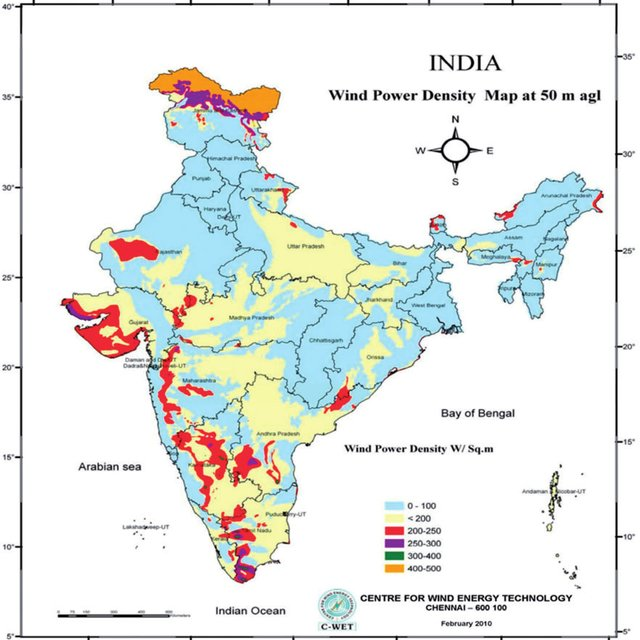Wind energy in India
2022 AUG 31
Mains >
Science and Technology > Energy > Renewable energy
IN NEWS:
- Annual installation of new wind power projects in India will peak by 2024 and likely decline thereafter, according to a recently released report.
- India is expected to add 3.2 GW in 2022, 4.1 GW in 2023 peaking to 4.6 GW in 2024, thereafter declining to 4 GW and 3.5 GW in the next two years, respectively, according to the report.
CURRENT STATUS:
- India has attained 4th position globally in wind power installed capacity.
- So far, 40 GW of wind power capacity has been established, amounting to 10 percent of total installed capacity of India.
- But only 1.45 GW of wind projects were installed in 2021 with many delayed due to the second wave of COVID-19 and supply chain-related disruptions.
- After 2024, fresh projects are likely to be wind-solar hybrid projects.

INDIA’S OPPORTUNITIES:
- Combat climate change:
- Wind energy offers a solution for India to successfully meet its INDC commitments towards combating climate change.
- Attain energy security:
- 90% of primary energy demands are met through imports. Increasing the share of wind energy can fulfil India’s clean energy demands, diversifying its energy basket and reduce import bill.
- Geographical potential:
- Assessment indicates a gross wind power potential of 302 GW in the country at 100 meter and 695.50 GW at 120 meter above ground level.
- India is also blessed with a coastline of about 7600 km and has good prospects of harnessing offshore wind energy.

- To meet rising energy needs:
- India suffers from chronic energy poverty. The Centre is also pushing for a full transition of mass e-mobility through initiatives like FAME-II and Make in India. Hence, there will be a rise in demand for electric power.
- Inclusive growth:
- Lowest ever wind tariff of Rs.2.43 per unit was registered in Gujarat in 2017. Thus, it can help promote the use of clean energy among the poorest sections of the society.
- Favourable government policy:
- As part of its transition away from fossil fuels, India has committed to sourcing half its electricity in 2030 from non-fossil fuel sources and installing 60 gigawatt of wind power by 2022.
GOVERNMENT INITIATIVES:
- National offshore wind energy policy:
- Ministry of New and Renewable Energy (MNRE) has been authorised as nodal ministry for use of offshore areas within the EEZ of the country.
- National Institute of Wind Energy (NIWE) has been authorised as the agency for development of offshore wind energy in the country.
- National wind-solar hybrid energy policy:
- The main objective of the Policy is to provide a framework for promotion of large grid connected wind - solar PV hybrid system for optimal and efficient utilization of transmission infrastructure and land.
- Ministry set a target of 5.0 GW of offshore wind installations by 2022 and 30 GW by 2030
- Under the category of wind-solar hybrid power plants, Wind Turbine Generators and Solar PV systems will be configured to operate at the same point of grid connection.
- Green energy corridor project:
- The project aims at synchronizing electricity produced from renewable sources, such as solar and wind, with conventional power stations in the grid, leading to an integrated grid across the nation.
- Policy for Repowering of Wind Power Projects:
- The objective of the policy is to promote optimum utilization of wind energy resources by creating a facilitative framework
- The process involves replacing old machines with fewer, larger and taller modern units which are quiet, more reliable and produce more electricity.
- Foreign direct investment (FDI):
- Government has permitted FDI up to 100 percent under the automatic route for renewable energy projects, including offshore wind energy projects.
CHALLENGES:
- Location specific:
- Since profitable power generation require good wind speed, most of the potential exists in seven Indian States: Gujarat, Rajasthan, Maharashtra, Tamil Nadu, Madhya Pradesh, Karnataka and Andhra Pradesh
- High capital investments:
- The capital costs of setting up a wind farm in India Rs 6.8-7.2 crore per megawatt (MW)
- Grid connectivity:
- Lack of necessary transmission infrastructure and power storage facilities limit the viability of integrating wind farms with conventional sources.
- Unviable tariffs:
- competitive bidding mechanism has forced cost of renewables to as low as Rs 2.44/unit, making business unviable for companies.
- Inordinate delays in project execution:
- Involvement of multiple agencies like MNRE, IREDA, electricity boards and electricity regulatory commissions makes setting up and operating wind farms difficult.
- Land acquisition challenges:
- Wind energy generation is not the most profitable way of using land.
- Capacity of roads:
- The unpaved and often twisty roads are not wide enough to carry the blades or equipments, which can exceed more than 100 feet each. This adds to the capital costs.
WAY FORWARD:
- Efficient storage facilities are vital for improving the reliability on renewable sources. Hence, research should be encouraged in the development indigenous storage facilities
- Power purchase agreement structure needs to be strengthened further to make renewable energy projects more bankable.
- Explore full potential: The country should exploit its wind energy potential to the maximum by encouraging the setting up of more wind farms and transmission infrastructure.
PRACTICE QUESTION:
Q. India’s wind energy potential remain underutilized. Examine the statement with special reference to the national wind-solar hybrid policy?

